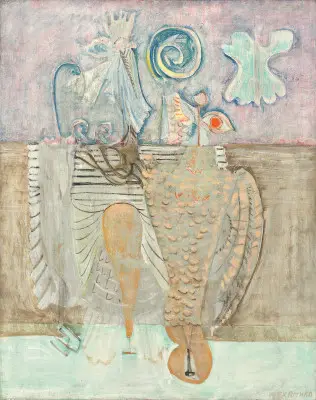Hierarchical Birds
Rothko’s imagery became more symbolic in the 1940s. The social climate full of anxiety as a result of the 1930s world war happenings began to appear outdated. If Rothko had to express human tragedies through art, he felt he needed to find new subjects as well as a new idiom. He put everything together in 1944 and came up with the historical Hierarchical Birds.
Setting
Hierarchical Birds demonstrates the interest of Rothko in classical literature. His early work was fascinated by mythical. Hierarchical Birds painting measures 100.7 by 80.5 cm and still remains in the National Gallery of Art, Washington, D.C. The painting portrays two bird like forms in the middle and amorphous shapes close to the top of the artistic painting. The background reveals a bright blue-pink section which reflects an Aegean drama. Divisions into sections call back the friezes of antique times when mythical stories were carved into stone.
According to Rothko, the painting does not deal with the specific anecdote but rather deals with a mythical spirit which remains generic to every myth at all times. The well painted picture is a unique peace which stands out in his many arts.
Style and Technique
The special design and unique features of this painting were achieved by a technique on painting specifically the use of brushwork and oil on canvas. Rothko mixed the paints himself and later added colour. The foundation was then fixed with oils creating a good base for paintings. The representation on the painting is based on myths which leaves us wondering how the painter arrived at such an amazing scene. The title of the great piece ‘Hierarchical Birds’ gives a hint that the art showcases birds which are a representation of mythical spirits.
Influences and Inspirations
World War II greatly influenced Rothko’s transitional decade. Matisse’s Red Studio was another great fascination in Rothko’s life. He accredits the studio as a key source of inspiration for his other paintings, which were done after the Matisse’s Red studio. Looking at the Matisse’s Red Studio, Rothko realised that painting could saturate you. He used the deep colour boldly just like Matisse. Apart from Matisse, Rothko was influenced by other great painters like Milton Avery, Friedrich Nietzsche and John D. Graham.
Just like he was influenced, Rothko has also influenced other painters like Adam Colier Noel, Francesca Gnagnarella and Kevin Stamper. His paintings were a great influence to this artists whose art works remain admirable. Though he is no more, the influence of Rothko in art work is still felt.

